May 12th, 2014 §
Last week most of my car trips included a chirping cardboard box riding shotgun. I delivered the chicks, which hatched in March, to their new owners. The little black pullet went to an acquaintance, a Wheaten Ameraucana pullet found a new and loving home with one of my Master Gardener friends, and the four Wheaten Ameraucana cockerels sold on CraigsList within an hour. Isn’t he handsome?
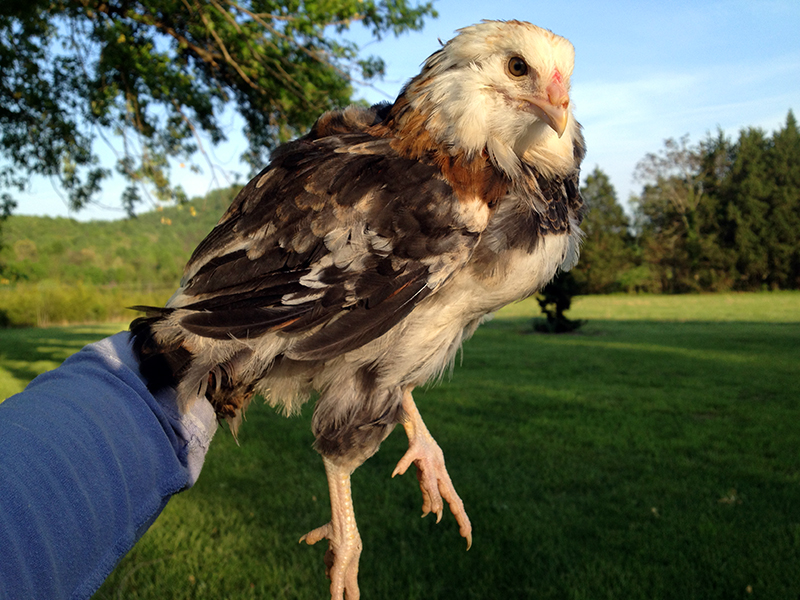
I kept two pullets. One is a pure Wheaten Ameraucana (in front below) and the other is a mystery hatched from a green egg out of a black mother! I love chickens at this age—about ten weeks—because they are sweet and curious, fully feathered but still small enough to pick up with one hand. They’re like little mini chicken pocket pets.
During the day I take the pullets out of their broody coop in the garage and put them in Tucker’s old puppy crate on the grass, and they eat their fill of clover, chickweed, whatever unfortunate bug comes along, and any grubs I unearth while digging in the garden. Last night they got to try pear for the first time.
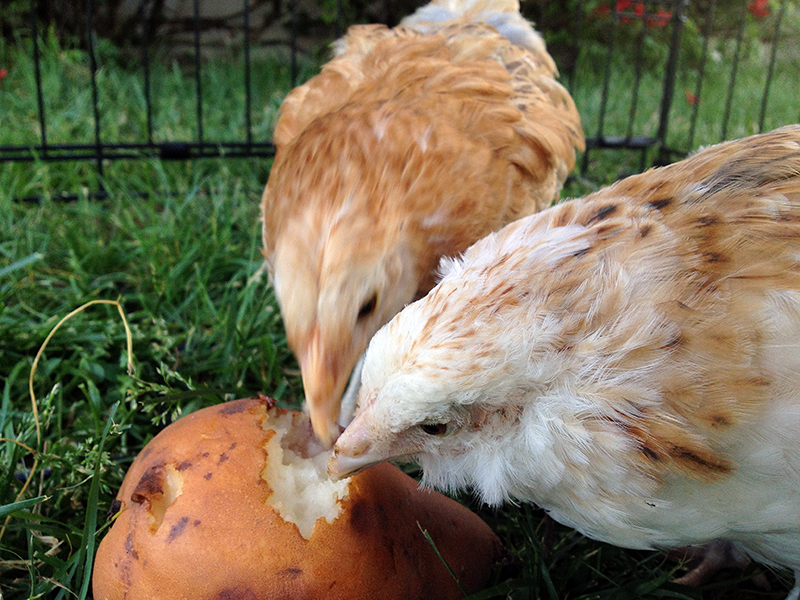

I am a bit sad that chick season is drawing to a close. If I could, I’d raise chickens all year long. I don’t think I will ever get tired of watching eggs turn into bright-eyed, beautiful birds.
Speaking of which, Mr. and Mrs. Bluebird are busy with their brood of four in the bluebird box. It’s wonderful to be back in bluebird season.
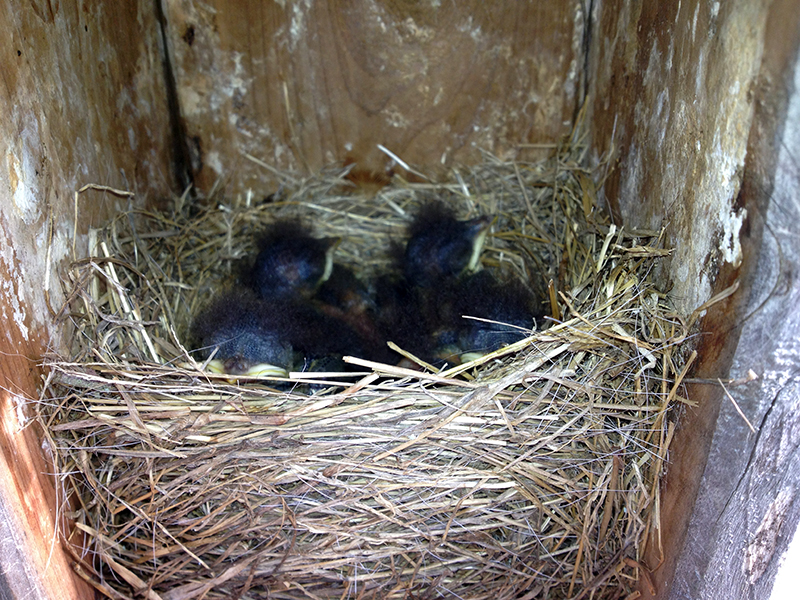
And finally, on a less joyful note, the feisty broody hen that hatched this latest batch of chicks wasn’t feisty enough when I returned her to the main flock. Despite holding her own for two days, on the eve of her third day back I found her with a quarter-size hole torn in the back of her skull. In her pain and panic to get away from her attackers she actually jumped into my arms from the nesting box. It’s the exact same wound Oregano sustained under similar circumstances, though this hen’s is worse.
She’s been getting daily Bactine spray and Neosporin plus Blue-Kote spray (which dyes her wound purple). I wish that I would have stitched her wound when I found it. She keeps knocking it open and it’s taking a very long time to heal, having to close from the outside in across basically her entire skull. In fact it’s larger now than it is in this photo, which I took a couple of weeks ago.
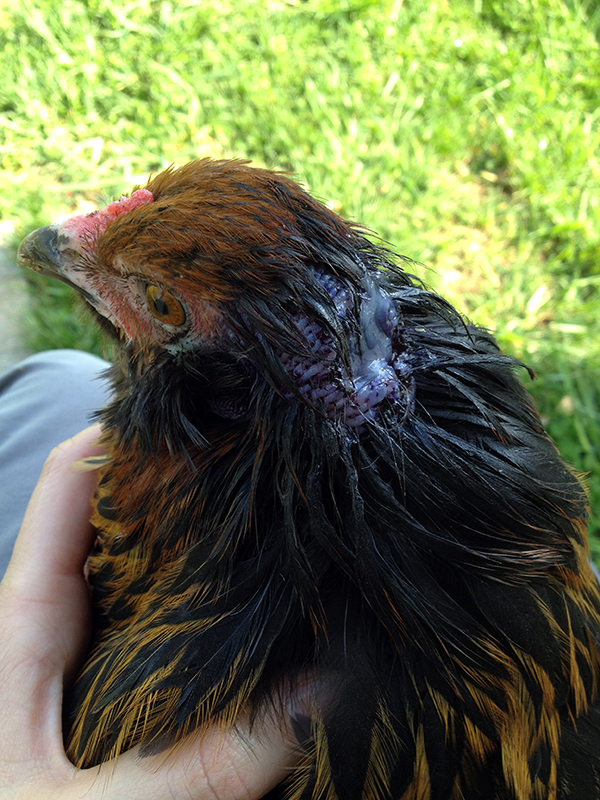
She doesn’t act hurt and has returned to laying eggs. As long as her wound doesn’t get infected I will just keep what I am doing and let it heal itself. My experience with Cora taught me that chickens can recover from the most dramatic wounds. This little hen is protected within another dog crate within the main coop, and will be until she heals and can successfully reintegrate with the flock.
This is what she gets for successfully raising the offspring of her sister flock mates. The injustice!
November 4th, 2013 §
Sunday morning dawned just a beautifully as Saturday, though it was cooler and substantially more windy. After lunch I headed outside to keep working at the vegetable garden cleanup. Unfortunately I had overdone it the day before and reactivated an old injury, a muscle spasm in my upper back next to my shoulder blade. In addition to being constantly uncomfortable, it makes turning my head to the right, such as when backing up the car, downright painful. Farming. Let me count the ways it hurts.
Regardless of any physical discomfort, the garden still needed more attention. First I dug out a couple dozen dahlia tubers for winter storage in the garage. I was amazed at the size of most of these tubers—just gigantic. Seeing this, I am suspicious that something caused this year’s dahlias to put their energy into making tubers instead of into flowers. More research on my theory to come.
I moved the dahlias’ labels, which are attached with twist-ties, from the wire support cages directly to the tubers to keep them properly labeled.
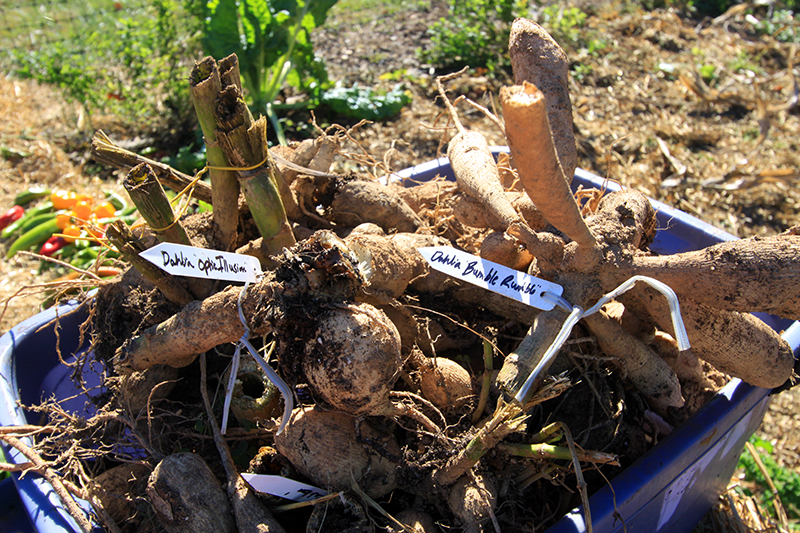
I stacked the custom-made cages and wired their ground pins to them for safekeeping. When I get around to it I will layer the tubers in boxes of peat to keep them from either drying out or rotting during winter. Last year I hung the tubers in mesh bags in the garage and lost some of them to drying out, so I will try a different technique this year.
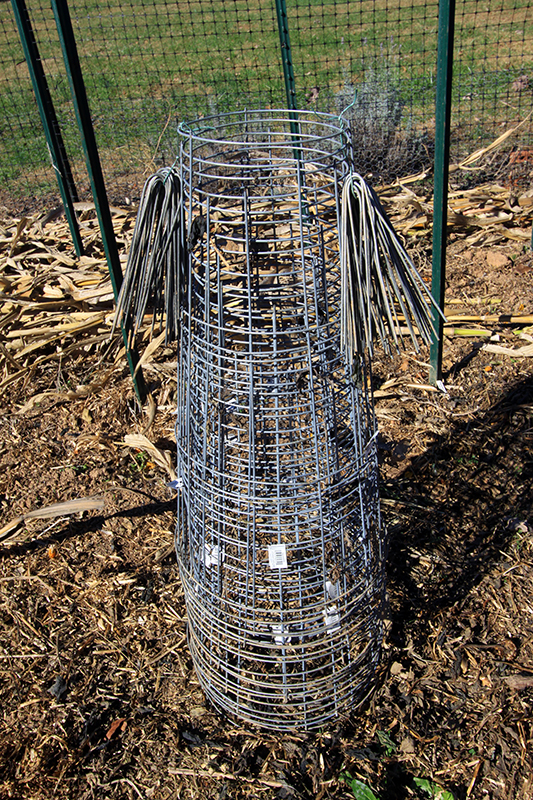
Then I had to figure out what to do with the Glass Gem corn stalks. I tried digging one stalk out, but the root ball that came with it was so massive and full of soil and beneficial worms that I realized I’d be transplanting most of my hard-won, improved garden soil directly into the woods if I chose that route. So I decided to chop each stalk off at the ground and hope that the root balls would just decompose and continue to feed the soil without the major disturbance of digging. We’ll see. I figured that come next spring, anything I’d want to plant in this area can be tucked amongst any stalks or root balls that may be left over.
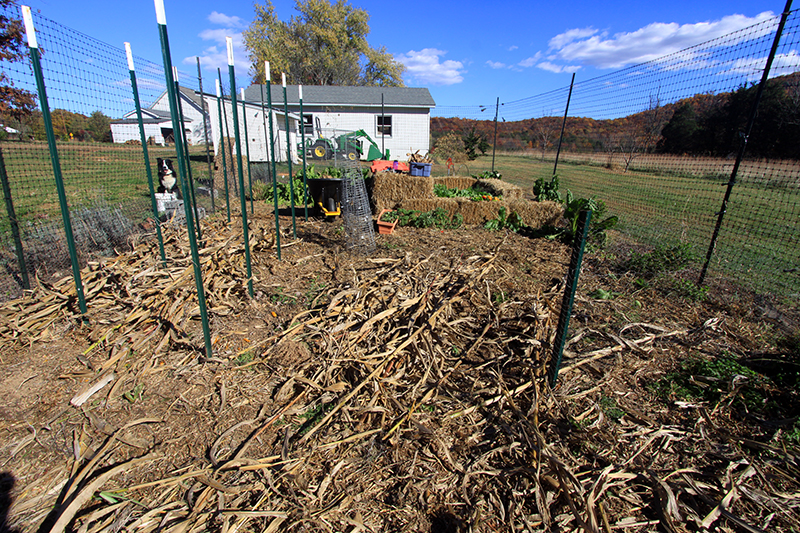
I am undecided about what to do with the stalks. I am heading toward leaving them on the ground over the garden. They will form a nice mulch layer to protect the soil below during winter, and if they’re still around in the spring they’ll be easy to pick up and remove to the compost pile. I plan on putting down a layer of compost then heavily mulching with straw anyway, so these corn stalks perform much the same function and help stretch the straw budget.
I still need to get the tomato stakes out, and then the next step involves shoveling compost into the garden and spreading straw. But as I was not in great compost-shoveling condition with this muscle knot, once I got the dahlias up and the corn down I quit garden cleanup and headed to town for an hour and half of vigorous vinyasa yoga in a warm studio, followed by liberal application of the gym’s hot tub jets to my back muscles.
July 15th, 2013 §
On Saturday it was time to cull the deformed chick and move Oregano back in with the main flock. Two odious tasks I’d been dreading.
Before removing the two broody hens to their nursery coops, I had finally achieved a nice, stable and harmonious flock. The rooster was sweetly keeping order, and every bird was finally in good health, all wounds were healed and parasites eradicated. Things were going along well. However, whenever a chicken is added or subtracted from a flock, a power vacuum opens and each bird scrambles to attain the highest possible spot in the pecking order. The birds don’t “remember” a former flock mate, even if she was only out of the coop for a month. To all of them Oregano is a stranger, and their instinct is to kill her in order to preserve their own position in the flock.
So I know all this going in, thus the dread, and I tried a few things to see if I could smooth the transition. I put Oregano in the little run outside of the coop and released Calabrese, the rooster, from inside. I figured if he accepted Oregano back in to the flock he would perhaps help protect her from attack by the other hens, or they would see her as less of a threat if she had her baby-daddy on her side.
But when the two of them got together, this happened:
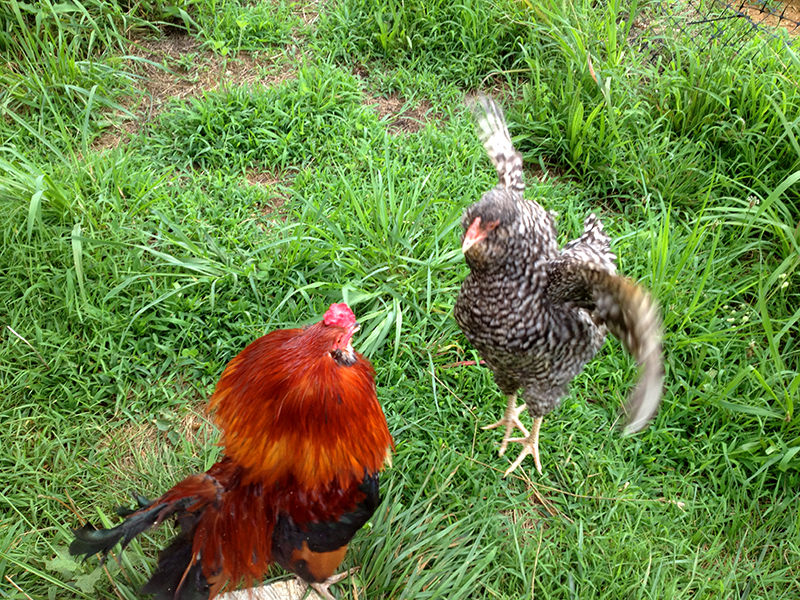
Then this:
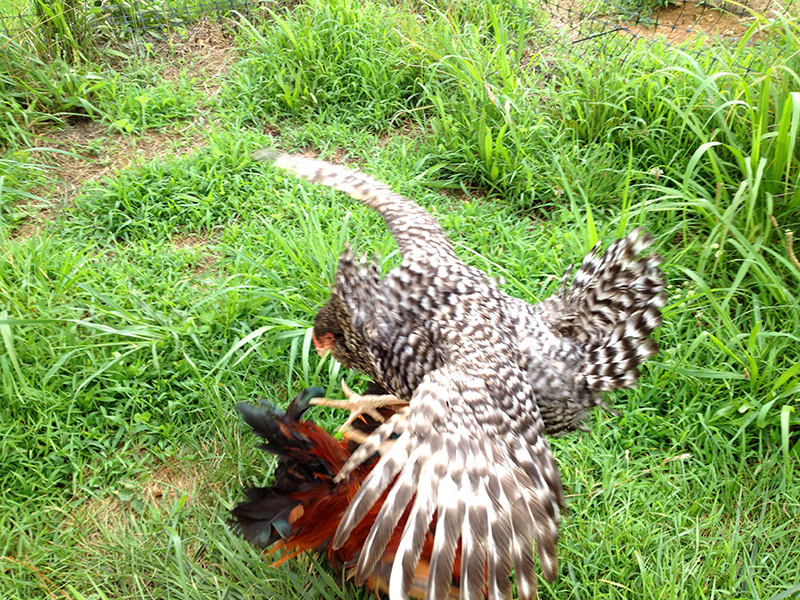
And this:
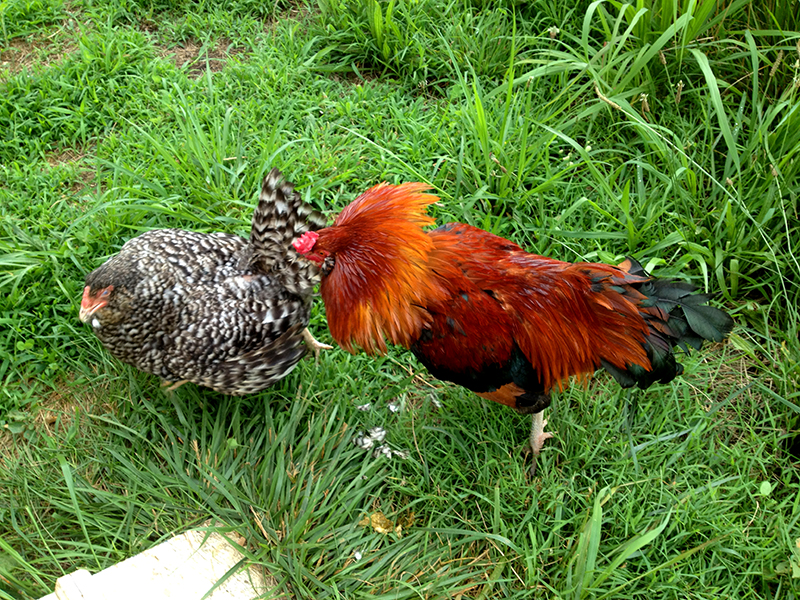
The birds went at each other in a dazzling display of spread feathers and clashing claws. Oregano puffed herself up as large as possible as she fended off Calabrese. Between attacks Calabrese “danced” for Oregano, so he was definitely conflicted about whether to fight or flirt with this “new” bird, with whom he had one biological offspring growing up in a nearby coop.
After things settled a bit I let the other hens out, one by one. Most hens ignored Oregano, and so I thought I was in the clear. So I released them all into the yard, hoping that some free ranging would give them something to occupy their thoughts and diffuse any potential conflicts. The flock ran out, and Oregano ran into the coop. She seemed grateful to be home again and started eating right away. Things seemed to be going okay.
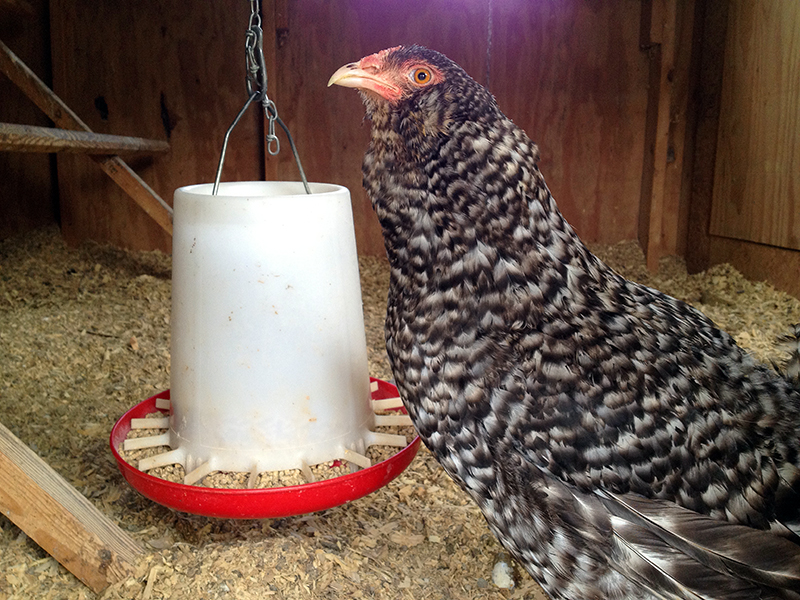
Then I went out in the evening and found the flock, minus Oregano, hanging out at the compost pile in the woods. Oregano was huddled under the fig by the garage, hiding. She had been shunned, and had to take shelter.
I called all the chickens back to the run behind the coop to force them to be together in a slightly smaller space. The hens took turns jabbing at Oregano’s head and she ran amongst them, head down and feathers fully puffed, looking like a football player lumbering down the field. It’s wasn’t peaceful but she seemed to be holding her own. And this was really her own battle to fight. There’s nothing I could do as they jousted.
Oregano spent the night sleeping in a nesting box—a good defensive position—with the other birds on the roosts. Sunday morning all seemed okay, but I had to go out of town for the day and was very nervous to leave the unstable flock cooped up all day. With no where to run, the confined area can be fatal (see Cora’s scalping and near-death experience last summer). But there wasn’t anything I could do as I had promised to go.
Last night I got home around seven and opened the coop immediately after parking the car. As I had feared, I found that Oregano had been attacked.
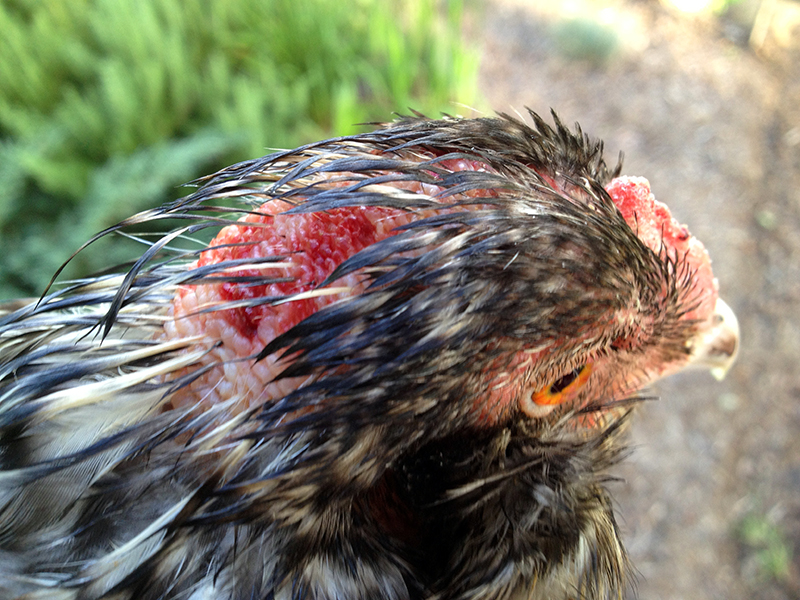
Her head and comb were torn open and bloody. So the first thing I did, before even letting my poor dog out to pee, was to grab Oregano and bring her inside for first aid. She didn’t even struggle.
Oregano got a Bactine cleansing, then a nice coat of Neosporin. I covered that with a thick layer of black salve, which supposedly tastes bad to attacking chickens. Over all that I sprayed Blu-Kote, a wound dressing. It masks the red blood color that encourages chickens to continue pecking. By the time she was done she looked a fright, but hopefully it would be enough to get her healed and keep the other birds off of her. The good news is that when I checked on the birds this afternoon Oregano didn’t seem to have suffered further injury, so hopefully her disguise is working.

This poor girl. All she wanted to do was have a family. And after a month of sacrificing her own health, she lost her chick, was turned on by her former flockmates, and suffered injury at their beaks. I wanted to raise chicks with broody hens, because it’s less work for me, but I am not sure if the tumultuous flock dynamics makes it worth it. I still have Dahlia to get incorporated back into the flock, and the six babies. Better get a bigger tube of Neosporin…














